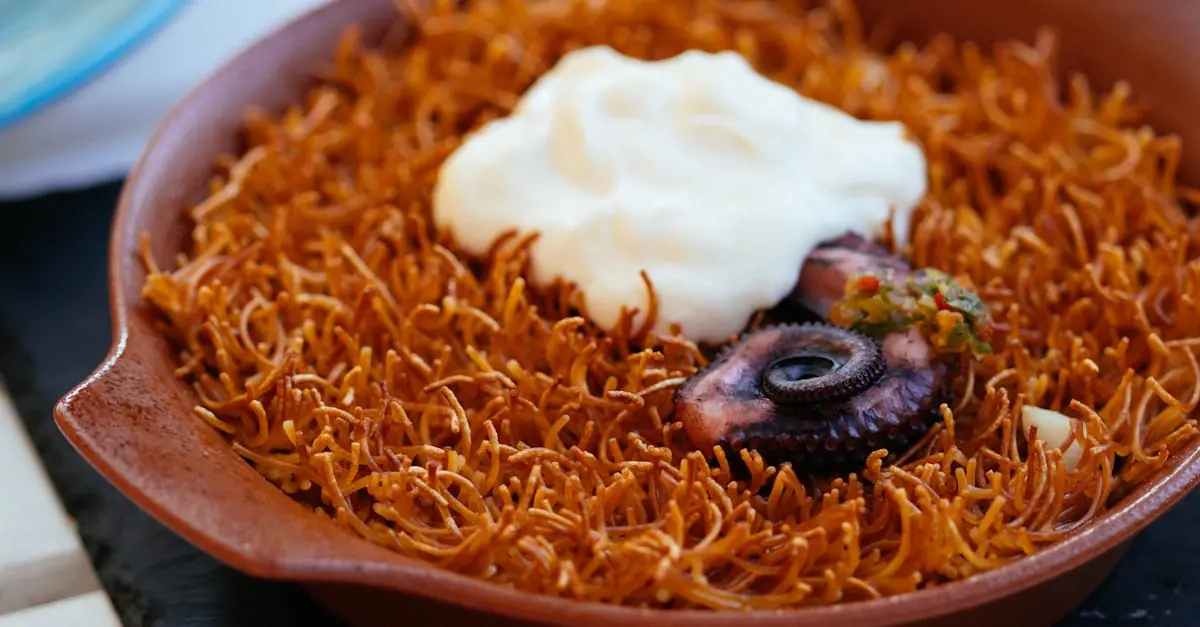Imagine dipping crispy fries into a creamy, garlicky concoction that elevates every bite to culinary bliss. That’s the magic of aioli—a sauce so delicious it could make a cardboard box taste gourmet. Whether it’s drizzled over grilled veggies or slathered on a sandwich, this Mediterranean delight is a must-have in any kitchen.
Table of Contents
ToggleIngredients Needed for Aioli
To create delicious aioli, certain key ingredients are necessary. They combine to deliver that rich, savory flavor.
Primary Ingredients
Garlic serves as the foundation of aioli. Fresh cloves provide strong flavor. Egg yolk acts as an emulsifier, helping to blend ingredients together smoothly. Extra virgin olive oil contributes richness and depth. Lemon juice adds acidity, balancing flavors and enhancing brightness. Salt enhances all the components, ensuring a well-rounded taste.
Optional Ingredients
Different ingredients can add unique twists to aioli. Mustard gives an additional tanginess, making it more complex. Herbs such as basil or parsley introduce freshness and vibrant color. Spices like paprika or cayenne pepper bring heat and excitement. Other flavor enhancers include capers or anchovies, which infuse umami notes. Variations can create personalized versions, adapting to individual taste preferences.
Traditional Aioli Recipe
Creating traditional aioli involves simple yet essential ingredients. The process starts with fresh garlic, which serves as the base flavor.
Step-by-Step Instructions
- Crush garlic using a mortar and pestle until it becomes a smooth paste.
- Add an egg yolk, beating it gently to combine with the garlic.
- Slowly stream in extra virgin olive oil while whisking continuously until the mixture thickens.
- Incorporate lemon juice to achieve the desired acidity, followed by a pinch of salt for seasoning.
- Taste and adjust flavors, adding herbs or spices if preferred.
Tips for Success
- Use fresh ingredients for the best flavor, especially garlic and olive oil.
- Whisk vigorously to ensure proper emulsification, which provides a creamy texture.
- Avoid overheating during preparation; keep ingredients at room temperature for optimal blending.
- Experiment with flavors by adding mustard or herbs, tailoring the aioli to personal taste preferences.
- Store aioli in the refrigerator for up to four days, ensuring it remains fresh and safe to consume.
Variations of Aioli
A variety of aioli adaptations exist, allowing for distinct flavors and dietary preferences. Exploring these variations can enhance the culinary experience.
Flavor Enhancements
Herbs contribute freshness to aioli. Basil, cilantro, and dill can introduce bright notes. Adding spices like smoked paprika or cayenne pepper introduces warmth and complexity. For a tangy twist, incorporating mustard or capers works well. Experimenting with roasted garlic adds sweetness, while citrus zests, such as lemon or lime, provide bright acidity. These enhancements create unique profiles suitable for diverse dishes.
Dietary Adaptations
Vegetarians benefit from aioli made without eggs, using aquafaba as an emulsifier instead. Vegans can achieve similar textures and flavors through this replacement. Gluten-free variations rely on the core ingredients, ensuring no cross-contamination with gluten sources. Low-fat aioli uses Greek yogurt for creaminess, cutting calories while maintaining rich flavor. These adaptations cater to various dietary needs, ensuring everyone can enjoy this versatile sauce.
Common Mistakes to Avoid
Making aioli involves precision, and avoiding common mistakes ensures the best flavor and texture.
Over-Emulsifying
Over-emulsifying aioli leads to a broken sauce with a grainy texture. Achieving the right consistency requires a gradual addition of oil while whisking. If the oil is incorporated too quickly, emulsification fails, resulting in a less appealing end product. Recognizing the signs of over-emulsification is key. A well-made aioli should be creamy and smooth, not thick or clumpy. If the mixture does thicken too much, consider adding a few drops of water and whisking gently to restore the desired texture.
Ingredient Substitutions
Using incorrect ingredient substitutions often alters the flavor profile of aioli. Fresh garlic plays an essential role in delivering authentic taste. While substituting garlic powder seems convenient, it diminishes the intended flavor. Extra virgin olive oil is preferred for richness, but using other oils may result in a lighter texture. If looking for alternatives, consider avocado oil as a healthy option. Substituting lemon juice with vinegar changes the acidity level, impacting overall flavor balance. Sticking to the primary ingredients guarantees the savory experience aioli is known for.
Making aioli is a rewarding culinary experience that can transform ordinary dishes into extraordinary ones. With a few simple ingredients and a bit of technique anyone can create this rich and flavorful sauce. The versatility of aioli allows for endless adaptations ensuring it fits various tastes and dietary needs.
By following the tips and techniques outlined in the article anyone can avoid common pitfalls and achieve the perfect texture and flavor. Whether enjoyed with fries grilled vegetables or as a sandwich spread aioli is sure to impress. It’s time to unleash creativity in the kitchen and elevate meals with this delightful sauce.




